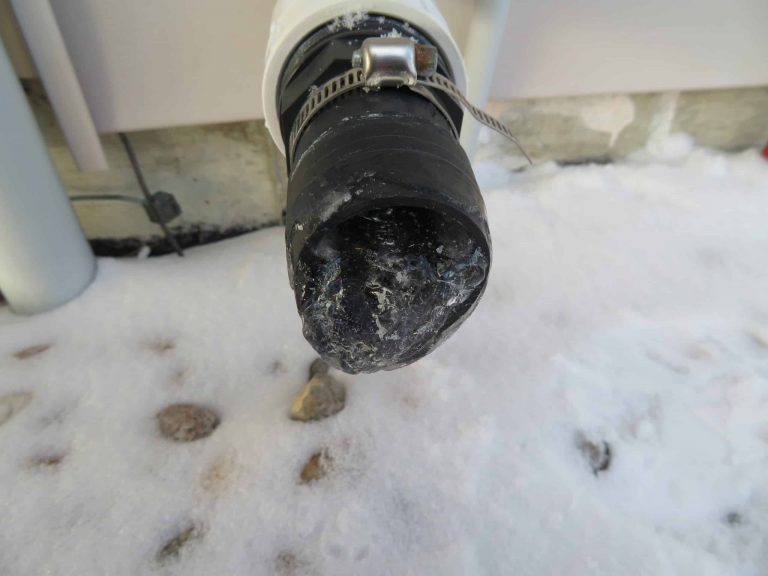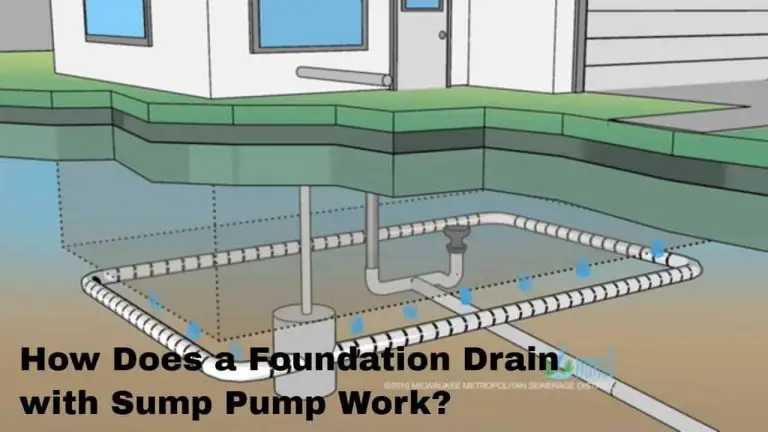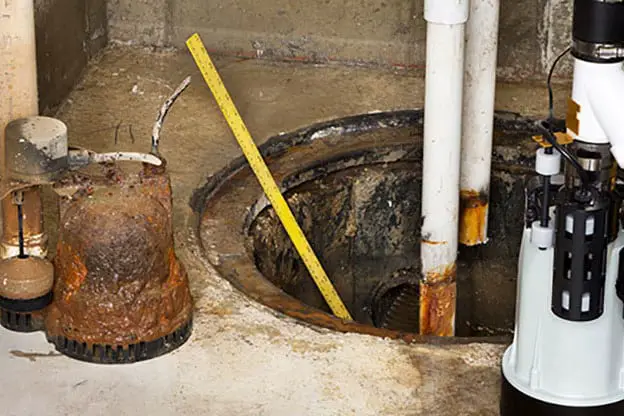Can a Sump Pump Discharge Outside
A sump pump is a device that is installed in the basement of a home. Its purpose is to remove water that has accumulated in the sump pit and to prevent flooding. A sump pump discharge pipe is used to route water away from the house and can be directed to an existing drainage system, such as a dry well, or discharged outdoors.
If you are considering discharging your sump pump water outdoors, there are a few things you should know.
If you live in an area that is prone to flooding, you may be wondering if a sump pump discharge outside is a good idea. The answer is yes! A sump pump discharge outside can help to keep your basement dry and free from water damage.
There are a few things to consider when deciding whether or not to discharge your sump pump outside. First, you will need to make sure that the area around your home is able to handle the extra water. If your property does not have proper drainage, the additional water from the sump pump could cause problems.
Second, you will need to check with your local municipality to see if there are any regulations or restrictions on discharging water into the sewer system.
Assuming that both of these items check out, then discharging your sump pump outside is a great way to protect your home from flooding. By doing so, you can avoid costly repairs and Water Damage Restoration caused by basement flooding.
How To Properly Discharge A Sump Pump – Milton DE
Sump Pump Discharge Pipe Outside
If your home is built on a slope or in an area that is prone to flooding, you may have a sump pump installed in your basement. This pump helps to prevent water from entering your home and causing damage. The sump pump discharge pipe carries water away from your home and into the storm sewer or another drainage system.
It’s important to keep the sump pump discharge pipe clear so that it can function properly. If the pipe becomes blocked, water could back up into your basement. To clean the discharge pipe, start by disconnecting it from the sump pump.
Then, use a garden hose to flush out any debris that may be blocking the pipe. Once the pipe is clear, reconnect it to the sump pump and test it to make sure it’s working properly.
If you live in an area with cold winters, it’s also important to take steps to prevent your sump pump discharge pipe from freezing.
One way to do this is to keep thepipe above ground level so that it’s exposed to air and less likely to freeze solid. You can also insulate the pipe with foam insulation or wrap it in electric heating tape. Taking these precautions will help ensure that your sump pump can continue to protect your home even during extreme weather conditions.
Where to Run Sump Pump Discharge
If you have a sump pump in your home, you know that it’s an important part of keeping your basement dry. But what you may not know is where to run the discharge from your sump pump.
The most important thing to remember is that the discharge from your sump pump must be directed away from your home.
This is because the water that is discharged from the pump contains pollutants and contaminants that can harm your family if they come into contact with it.
There are a few different options for where to run the discharge from your sump pump. One option is to direct it into a storm sewer or catch basin.
This is a good option if your municipality has one available. Another option is to direct the discharge into a dry well. Dry wells are specifically designed to hold water and prevent it from seeping into the ground around your home.
No matter which option you choose, make sure that you follow any regulations or guidelines set forth by your municipality. And always make sure that the discharge from your sump pump is directed away from your home!
Underground Sump Pump Discharge
An underground sump pump discharge is a great way to keep your basement or crawl space dry. This type of pump is installed below ground level and pumps water away from your home, preventing flooding and water damage. There are many benefits to having an underground sump pump discharge, including:
1. Protection from Flooding – If you live in an area that is prone to flooding, an underground sump pump can provide much-needed protection for your home. By pumping water away from your foundation, you can avoid costly repairs due to water damage.
2. Prevent Basement or Crawl Space Water Damage – In addition to protecting your home from floodwaters, an underground sump pump can also prevent basement or crawl space flooding due to heavy rains.
By keeping these areas dry, you can avoid mold growth and other moisture-related problems.
3. Peace of Mind – Knowing that your home is protected from floods and other water damage can give you peace of mind during severe weather conditions. You can rest assured that your family and belongings are safe while the storm passes through.
If you live in an area where floods are a concern, consider installing an underground sump pump discharge system.
Pvc Sump Pump Discharge Pipe
A sump pump is a device that is used to remove water that has accumulated in a sump pit. A sump pump discharge pipe is a pipe that is connected to the sump pump and drains water away from the sump pit. The discharge pipe typically runs from the sump pit to an area where the water can be discharged, such as a storm drain or dry well.
If you have a sump pump in your home, it is important to make sure that the discharge pipe is properly installed and maintained. If the discharge pipe becomes clogged, it can cause the sump pump to malfunction and potentially flood your basement.
Sump Pump Discharge Overflow
When your sump pump discharge pipe overflows, it can cause a lot of damage to your home. If the water is coming from a storm or flood, it can be contaminated with sewage and other contaminants. If the overflow is caused by a broken or malfunctioning sump pump, it can damage your foundation, walls, and floors.
If you have a sump pump discharge pipe that is overflowing, you should call a plumber to fix the problem as soon as possible. In the meantime, you can try to redirect the water flow away from your home by using sandbags or other barriers. You should also avoid using any electrical appliances or outlets near the flooded area.
Sump Pump Drainage System
A sump pump is a device that is used to remove water that has accumulated in a water-collecting sump basin. The water is typically pumped out of the basement or crawlspace and away from the home’s foundation. Sump pumps are used where flooding occurs frequently and can be operated automatically or manually.
A sump pump drainage system can be a simple as a pipe leading from the sump pit to an area where the water can drain away from your home. Or it can be more complex, with multiple pipes and valves leading to different areas depending on the amount of rainfall. You may also have a backup sump pump in case your primary pump fails.
If you live in an area prone to flooding, talk to a professional about installing a sump pump drainage system in your home. It could save you thousands of dollars in repairs down the road!

Credit: www.youtube.com
Can a Sump Pump Drain Outside?
Yes, a sump pump can drain outside, but there are a few things to keep in mind. First, you’ll need to make sure that the discharge pipe is properly installed and pitched so that water will flow away from your home. Second, you’ll need to be careful of any potential freezing issues in colder climates – if the discharge pipe freezes, it could cause serious damage to your home.
Finally, you should check with your local municipality to see if there are any restrictions on discharging water onto the ground or into storm drains.
Where Do You Drain a Sump Pump Outside?
Most sump pumps are installed in the basement of a home, and they are used to pump water out of the basement and away from the foundation of the house. If your sump pump is located in the basement, it is most likely draining into a pit that is dug into the floor. The pit is usually filled with gravel or stones to help keep the water flowing away from the house.
If you have a sump pump that is not located in the basement, it is probably draining into a dry well. A dry well is a hole that is dug into the ground and then filled with gravel or stones. The dry well allows water to drain away from your house so that it will not cause any damage to your foundation.
Where Should the Sump Pump Drain To?
A sump pump is a device that is used to remove water that has accumulated in a water-collecting basin, commonly found in the basement of homes. The water is typically pumped out of the home and away from the foundation to avoid flooding and structural damage. While most sump pumps are equipped with a built-in outlet that allows for easy connection to a garden hose, some pumps may require the use of an adapter in order to connect to this type of drainage system.
There are several factors to consider when deciding where to drain your sump pump. One important factor is the location of your home’s sewer line. If your home’s sewer line is located near your foundation, it is best to avoid draining your sump pump into this system as it can cause sewage back-up into your home during periods of heavy rain or snowmelt.
Additionally, you will want to choose a location that is far enough away from your home so that any water that does accumulate will not cause flooding or damage to your property. A good rule of thumb is to choose a spot that is at least 10 feet away from any structures on your property.
Another factor to consider when deciding where to drain your sump pump is the soil type in your yard.
If you have sandy soil, it may be necessary to drill a hole in order for the water to drain properly and prevent pooling around the discharge pipe. For homes with clay soil, it may be necessaryto install a French drain – which consists of perforated pipe surrounded by gravel – in order for the waterto seep into the ground and away from any structures on your property.
Once you have selected an appropriate location for draining your sump pump, you will needto install proper drainage piping from the discharge outlet on the pump itself tothedrainage destination.
This piping should be made of durable materials such as PVC or metal sothat it can withstand being buried underground if necessary. It should also be sloped slightlyso that water flows easily through it without pooling or causing blockages.
Can You Discharge a Sump Pump to the Street?
There are a few things to consider when deciding whether or not to discharge your sump pump to the street. The first is whether or not your municipality allows it. Some municipalities have regulations in place that prohibit discharging sump pump water to the street.
You’ll need to check with your local authorities to see if this is the case where you live. Even if your municipality does allow it, there may be some restrictions in place, such as only being able to discharge during certain times of day or only being able to discharge a certain amount of water at a time.
Assuming you are allowed to discharge your sump pump water to the street, there are a few things you’ll need to do to ensure it’s done properly.
First, you’ll need to make sure the outlet from your sump pump is directed away from any foundation walls or landscaping features on your property. This will help prevent any flooding or damage that could occur if water was allowed to build up against these surfaces. Second, you’ll need to install a backflow prevention device on the outlet pipe.
This will ensure that water can only flow out of the pipe and not back into your home should there be a power outage or other issue that causes the water level in the street to rise above the level of your sump pit.
If you follow these guidelines, discharging your sump pump water into the street can be a safe and effective way of preventing basement flooding and protecting your home from water damage.
Conclusion
If you live in an area with a high water table, your home is at risk for flooding. A sump pump is a great way to protect your home from flooding, but did you know that a sump pump discharge can actually cause flooding outside of your home?
The answer is yes, a sump pump discharge can cause flooding outside of your home if it is not properly directed.
When water is pumped out of the sump pit, it needs to be discharged away from the foundation of your home in order to avoid flooding. If the water is discharged too close to the foundation, or if there is nowhere for the water to drain, it will pool around your foundation and potentially seep into your basement or crawlspace.
To avoid this problem, make sure that you direct the discharge pipe away from your foundation and into an area where the water can drain safely.
You may also want to consider installing a backflow valve on the discharge pipe to prevent floodwater from flowing back into your sump pit.






